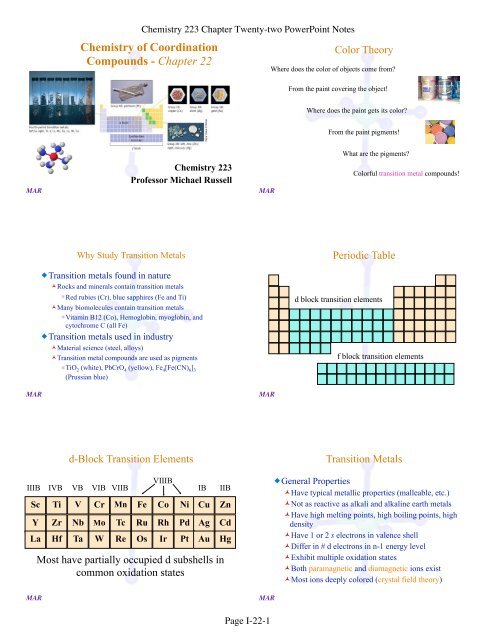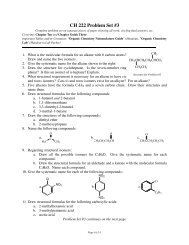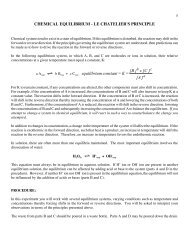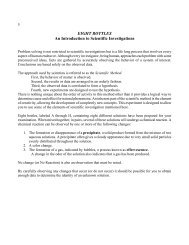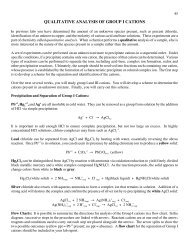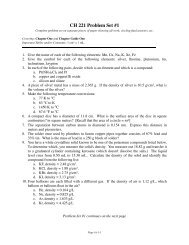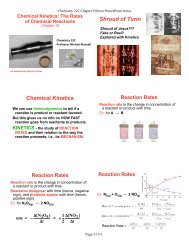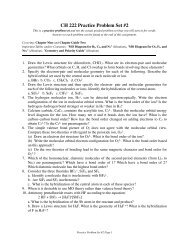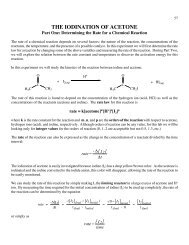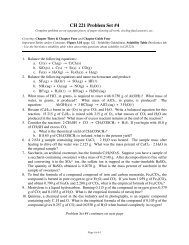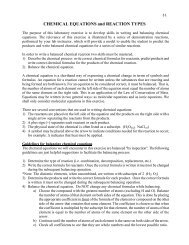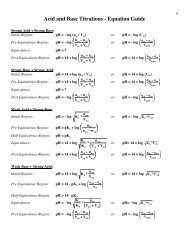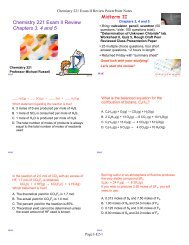Chemistry of Coordination Compounds - Chapter 22 - MhChem ...
Chemistry of Coordination Compounds - Chapter 22 - MhChem ...
Chemistry of Coordination Compounds - Chapter 22 - MhChem ...
You also want an ePaper? Increase the reach of your titles
YUMPU automatically turns print PDFs into web optimized ePapers that Google loves.
MAR<br />
MAR<br />
MAR<br />
<strong>Chemistry</strong> <strong>of</strong> <strong>Coordination</strong><br />
<strong>Compounds</strong> - <strong>Chapter</strong> <strong>22</strong><br />
<strong>Chemistry</strong> <strong>22</strong>3<br />
Pr<strong>of</strong>essor Michael Russell<br />
Why Study Transition Metals<br />
�Transition metals found in nature<br />
�Rocks and minerals contain transition metals<br />
�Red rubies (Cr), blue sapphires (Fe and Ti)<br />
�Many biomolecules contain transition metals<br />
�Vitamin B12 (Co), Hemoglobin, myoglobin, and<br />
cytochrome C (all Fe)<br />
�Transition metals used in industry<br />
�Material science (steel, alloys)<br />
�Transition metal compounds are used as pigments<br />
�TiO2 (white), PbCrO4 (yellow), Fe4[Fe(CN) 6] 3<br />
(Prussian blue)<br />
d-Block Transition Elements<br />
VIIIB<br />
IIIB IVB VB VIB VIIB IB IIB<br />
Sc Ti V Cr Mn Fe Co Ni Cu Zn<br />
Y Zr Nb Mo Tc Ru Rh Pd Ag Cd<br />
La Hf Ta W Re Os Ir Pt Au Hg<br />
Most have partially occupied d subshells in<br />
common oxidation states<br />
<strong>Chemistry</strong> <strong>22</strong>3 <strong>Chapter</strong> Twenty-two PowerPoint Notes<br />
MAR<br />
MAR<br />
MAR<br />
Page I-<strong>22</strong>-1<br />
Color Theory<br />
Where does the color <strong>of</strong> objects come from?<br />
From the paint covering the object!<br />
Where does the paint gets its color?<br />
From the paint pigments!<br />
What are the pigments?<br />
Colorful transition metal compounds!<br />
Periodic Table<br />
d block transition elements<br />
f block transition elements<br />
Transition Metals<br />
�General Properties<br />
�Have typical metallic properties (malleable, etc.)<br />
�Not as reactive as alkali and alkaline earth metals<br />
�Have high melting points, high boiling points, high<br />
density<br />
�Have 1 or 2 s electrons in valence shell<br />
�Differ in # d electrons in n-1 energy level<br />
�Exhibit multiple oxidation states<br />
�Both paramagnetic and diamagnetic ions exist<br />
�Most ions deeply colored (crystal field theory)
MAR<br />
MAR<br />
Electronic Configurations<br />
� Sc�� � � � [Ar]3d14s2 �V�� � � � [Ar]3d34s2 �Cr�� � � � [Ar]3d54s1 �Mn� � � � [Ar]3d54s2 �Fe�� � � � [Ar] 3d64s2 Ni�� � � � [Ar] 3d84s2 �Cu�� � � � [Ar]3d104s1 �Zn�� � � � [Ar]3d104s2 Element Configuration<br />
Electronic Configurations <strong>of</strong> Transition Metal Ions<br />
Electronic configuration <strong>of</strong> Fe ions:<br />
Fe – 2e - → Fe 2+<br />
[Ar]3d 6 4s 2 [Ar]3d 6<br />
- e - → Fe 3+<br />
[Ar]3d 5<br />
valence ns electrons<br />
removed first,<br />
then n-1 d electrons<br />
<strong>Coordination</strong> <strong>Chemistry</strong><br />
Transition metals act as Lewis acids and form<br />
complexes or complex ions with Lewis bases or<br />
ligands<br />
Fe<br />
Lewis acid Lewis base Complex ion<br />
3+ (aq) + 6 CN- (aq) → Fe(CN) 3-<br />
6 (aq)<br />
Ni<br />
Lewis acid Lewis base Complex ion<br />
2+ (aq) + 6 NH3(aq) → Ni(NH 2+<br />
3) 6 (aq)<br />
Complex contains central metal ion bonded to one or more<br />
molecules or anions<br />
Lewis acid = metal = center <strong>of</strong> coordination<br />
Lewis base = ligand = molecules/ions covalently bonded<br />
to metal in complex<br />
MAR<br />
<strong>Chemistry</strong> <strong>22</strong>3 <strong>Chapter</strong> Twenty-two PowerPoint Notes<br />
Oxidation States <strong>of</strong> Transition Elements<br />
Sc Ti V Cr Mn Fe Co Ni Cu Zn<br />
+1 +1<br />
+2 +2 +2 +2 +2 +2 +2 +2 +2<br />
+3 +3 +3 +3 +3 +3 +3 +3 +3<br />
+4 +4 +4 +4 +4 +4<br />
+5 +5 +5 +5<br />
+6 +6 +6<br />
+7<br />
MAR<br />
loss <strong>of</strong> ns e-s loss <strong>of</strong> ns and (n-1)d e-s MAR<br />
MAR<br />
Page I-<strong>22</strong>-2<br />
Paramagnetism and Diamagnetism<br />
Paramagnetic species have unpaired electrons while<br />
diamagnetic species have all paired electrons<br />
Paramagnetic species are attracted or repulsed by<br />
magnetic fields; the magnitude <strong>of</strong> the effect depends<br />
on the number <strong>of</strong> unpaired electrons<br />
Examples:<br />
Paramagnetic Cr [Ar]<br />
Diamagnetic Pd [Kr]<br />
<strong>Coordination</strong> <strong>Chemistry</strong><br />
3 d 4s<br />
4 d 5s<br />
A coordination compound has one or more complexes.<br />
Examples: [Co(NH 3) 6]Cl 3, [Cu(NH 3) 4][PtCl 4],<br />
[Pt(NH 3) 2Cl 2]<br />
The coordination number is the number <strong>of</strong> donor atoms<br />
bonded to the central metal atom or ion in the complex.<br />
� Example: [Co(NH 3) 6] 3+ coordination number = 6<br />
� Example: [PtCl 4] 2- coordination number = 4<br />
Most common = 6, 4 and 2<br />
<strong>Coordination</strong> number determined by ligands
<strong>Coordination</strong> Number Geometry<br />
MAR<br />
Common Geometries <strong>of</strong> Complexes<br />
2<br />
Example: [Ag(NH 3) 2] +<br />
Linear<br />
Common Geometries <strong>of</strong> Complexes<br />
<strong>Coordination</strong> Number Geometry<br />
MAR<br />
6<br />
Examples: [Co(CN) 6] 3- , [Fe(en) 3] 3+<br />
MAR<br />
(most common <strong>of</strong> all metal<br />
coordination numbers)<br />
<strong>Coordination</strong> <strong>Chemistry</strong><br />
octahedral<br />
Ligands - aka Lewis bases<br />
�classified according to the number <strong>of</strong> bonds to<br />
central metal<br />
�"dentate" = "tooth"<br />
�Examples<br />
�monodentate = 1<br />
�bidentate = 2<br />
chelating agents<br />
�tetradentate = 4<br />
�hexadentate = 6<br />
�polydentate = 2 or more donor atoms<br />
<strong>Chemistry</strong> <strong>22</strong>3 <strong>Chapter</strong> Twenty-two PowerPoint Notes<br />
Common Geometries <strong>of</strong> Complexes<br />
<strong>Coordination</strong> Number Geometry<br />
MAR<br />
4 tetrahedral<br />
Examples: [Zn(NH 3) 4] 2+ , [FeCl 4] -<br />
4<br />
(most common)<br />
square planar<br />
(characteristic <strong>of</strong> metal ions with 8 d e - s)<br />
Example: [Ni(CN) 4] 2-<br />
+3<br />
[Fe(CN) 6] 3-<br />
anionic complex<br />
MAR<br />
MAR<br />
Page I-<strong>22</strong>-3<br />
and<br />
<strong>Coordination</strong> <strong>Chemistry</strong><br />
Charge <strong>of</strong> complex = sum <strong>of</strong> charges on the<br />
metal and the ligands<br />
Charge <strong>of</strong> coordination compound = sum <strong>of</strong><br />
charges on metal, ligands, and<br />
counterbalancing ions<br />
6(-1)<br />
+2<br />
[Co(NH 3) 6]Cl 2<br />
Monodentate Ligands<br />
Monodentate ligands possess only one<br />
accessible donor group.<br />
6(0) 2(-1)<br />
neutral compound<br />
H 2 O is a good example since all metal ions exist<br />
as aqua complexes in water<br />
Monodentate Ligand Examples:<br />
�H 2O, CN - , NH 3, NO 2 - , SCN - , OH - ,<br />
X - (halides), CO, O 2-<br />
Example Complexes:<br />
�[Co(NH 3) 6] 3+<br />
�[Fe(SCN) 6] 3-
MAR<br />
MAR<br />
MAR<br />
Bidentate Ligands<br />
Bidentate Ligands have "two teeth", able to bond<br />
with metal at two separate places<br />
Bidentate Examples:<br />
� oxalate ion = C 2O 4 2-<br />
� ethylenediamine (en) = NH 2CH 2CH 2NH 2<br />
� ortho-phenanthroline (o-phen)<br />
Example Complexes:<br />
� [Co(en) 3] 3+<br />
� [Cr(C 2O 4) 3] 3-<br />
� [Fe(NH 3) 4(o-phen)] 3+<br />
Bidentate Ligands<br />
Bidentate Ligands<br />
Another bidentate ligand:<br />
Dimethylglyoxime (dmg)<br />
Ni(dmg) 2 (from lab):<br />
<strong>Chemistry</strong> <strong>22</strong>3 <strong>Chapter</strong> Twenty-two PowerPoint Notes<br />
MAR<br />
MAR<br />
Bidentate Ligands<br />
oxalate ion ethylenediamine<br />
* *<br />
Donor Atoms<br />
Fe(o-phen) 3 2+ :<br />
MAR<br />
Page I-<strong>22</strong>-4<br />
EDTA<br />
ortho-phenanthroline<br />
*<br />
*<br />
* *<br />
Bidentate Ligands<br />
A commonly used polydentate ligand<br />
Forms 1:1 complexes with most<br />
metals except Group IA<br />
Forms stable, water soluble complexes<br />
High formation constants<br />
A primary standard material<br />
See the movie "Blade" (!)
*<br />
MAR<br />
MAR<br />
EDTA<br />
Six Donor Regions<br />
* *<br />
*<br />
*<br />
EDTA (Ethylenediamine tetraacetic acid) will adapt<br />
its coordination number to bond with the metal<br />
EDTA<br />
Formation constants (K f) for some<br />
metal - EDTA complexes.<br />
Ion log K Ion log K Ion log K<br />
Fe 3+ 25.1 Pb 2+ 18.0 La 3+ 15.4<br />
Th 4+ 23.2 Cd 2+ 16.5 Mn 2+ 14.0<br />
Cr 3+ 23.0 Zn 2+ 16.5 Ca 2+ 10.7<br />
Bi 3+ <strong>22</strong>.8 Co 2+ 16.3 Mg 2+ 8.7<br />
Cu 2+ 18.8 Al 3+ 16.1 Sr 2+ 8.6<br />
Ni 2+ 18.6 Ce 3+ 16.0 Ba 2+ 7.8<br />
Myoglobin, an Fe-containing<br />
MAR protein that stores O2 in cells<br />
<strong>Chemistry</strong> <strong>22</strong>3 <strong>Chapter</strong> Twenty-two PowerPoint Notes<br />
*<br />
Myoglobin<br />
C<br />
H<br />
MAR<br />
MAR<br />
M<br />
Porphine, an important<br />
chelating agent found in<br />
nature<br />
MAR<br />
Page I-<strong>22</strong>-5<br />
Oxymyoglobin<br />
O<br />
N<br />
<strong>Coordination</strong> Environment <strong>of</strong> Fe 2+ in<br />
Oxymyoglobin and Oxyhemoglobin<br />
EDTA<br />
Other Chelating Agents<br />
+
Nomenclature <strong>of</strong> <strong>Coordination</strong> <strong>Compounds</strong><br />
The cation is named before the anion. When naming a<br />
complex:<br />
� Cations named first, then anions. Anion metal gets<br />
� -ate ending<br />
� Ligands are named first in alphabetical order. Most<br />
ligands have -o ending; multiple ligands use Greek<br />
prefixes<br />
� Metal atom/ion is named last with the oxidation state in<br />
Roman numerals.<br />
� Use no spaces in complex name<br />
MAR<br />
MAR<br />
MAR<br />
� See <strong>Coordination</strong> <strong>Compounds</strong> Handout<br />
Nomenclature<br />
Co(H 2 O) 6 2+<br />
Hexaaquacobalt(II) ion<br />
H 2 O as a ligand is aqua<br />
Pt(NH 3 ) 2 Cl 2<br />
NH 3 as a ligand is ammine<br />
Cu(NH3 ) 2+<br />
4<br />
Tetraamminecopper(II) ion<br />
cis-diamminedichloroplatinum(II)<br />
Nomenclature: IUPAC Rules<br />
� [CoCl(NH 3 ) 5 ]Cl 2<br />
� pentaamminechlorocobalt(III) chloride<br />
� K 2 [Cd(CN) 4 ]<br />
� Potassium tetracyanocadmate(II)<br />
� NiCl 2 (en) 2<br />
� Dichlorobis(ethylenediamine)nickel(II)<br />
� CrCl 3 (C 4 H 8 O) 3 (C 4 H 8 O = tetrahydr<strong>of</strong>uran)<br />
� Trichlorotris(tetrahydr<strong>of</strong>uran)chromium(III)<br />
<strong>Chemistry</strong> <strong>22</strong>3 <strong>Chapter</strong> Twenty-two PowerPoint Notes<br />
MAR<br />
MAR<br />
MAR<br />
Page I-<strong>22</strong>-6<br />
Nomenclature: IUPAC Rules<br />
Neutral ligands are referred to by their usual name<br />
with these exceptions:<br />
�water, H 2O = aqua<br />
�ammonia, NH 3 = ammine<br />
�carbon monoxide, CO = carbonyl<br />
�hydroxide, OH - = hydroxo<br />
If the ligand name already contains a Greek prefix, use<br />
alternate prefixes for multiple occurrences:<br />
�bis-, 2; tris-, 3; tetrakis-,4; pentakis-, 5; hexakis-, 6<br />
�The name <strong>of</strong> the ligand is placed in parentheses; i.e.<br />
bis(ethylenediamine)<br />
[Ni(NH 2 C 2 H 4 NH 2 ) 3 ] 2+<br />
Cisplatin<br />
cis-[PtCl 2(NH 3) 2]<br />
square planar Pt(II)<br />
coordination number 4<br />
cis-isomer<br />
Pt(<br />
Nomenclature<br />
Tris(ethylenediamine)nickel(II) ion<br />
IrCl(CO)(PPh 3 ) 2<br />
Vaska’s compound<br />
Carbonylchlorobis(triphenylphosphine)iridium(I)<br />
the first <strong>of</strong> a series <strong>of</strong> platinum coordination complexbased<br />
anti-cancer drugs (Platinol-AQ)
MAR<br />
Isomerism<br />
Isomers are compounds that have the same<br />
composition but a different arrangement <strong>of</strong> atoms in<br />
space<br />
Important in inorganic and organic chemistry<br />
Major Types include:<br />
�coordination sphere isomers<br />
�linkage isomers<br />
�geometric isomers (cis, trans, mer, fac)<br />
�stereoisomers<br />
Linkage isomers differ in which<br />
atom <strong>of</strong> a ligand is bonded to Linkage Isomers<br />
the metal in the complex<br />
Consider [Co(NH3 ) 5 (ONO)] 2+<br />
and [Co(NH 3 ) 5 (NO 2 )] 2+<br />
a: pentaamminenitrocobalt(III)<br />
(yellow color)<br />
b: pentaamminenitritocobalt(III)<br />
MAR (red color) MAR<br />
MAR<br />
Geometric Isomers<br />
cis isomer trans isomer<br />
Pt(NH 3) 2Cl 2 - square planar<br />
<strong>Chemistry</strong> <strong>22</strong>3 <strong>Chapter</strong> Twenty-two PowerPoint Notes<br />
<strong>Coordination</strong> Sphere Isomers<br />
<strong>Coordination</strong> sphere isomers differ if a ligand is<br />
bonded to the metal in the complex, as opposed to<br />
being outside the coordination sphere (ionic<br />
bonding). Different reactivities!<br />
Consider [Co(NH 3) 5Cl]Br vs. [Co(NH 3) 5Br]Cl<br />
� [Co(NH 3) 5Cl]Br → [Co(NH 3) 5Cl] + + Br -<br />
� [Co(NH 3) 5Br]Cl → [Co(NH 3) 5Br] + + Cl -<br />
With AgNO 3:<br />
� [Co(NH 3) 5Cl]Br(aq) + AgNO 3(aq) →<br />
� � � [Co(NH 3) 5Cl]NO 3(aq) + AgBr(s)<br />
� [Co(NH3) 5Br]Cl(aq) + AgNO3(aq) →<br />
MAR<br />
� � � [Co(NH3) 5Br]NO3(aq) + AgCl(s)<br />
MAR<br />
Page I-<strong>22</strong>-7<br />
Geometric Isomers<br />
Geometric isomers have same types and number<br />
<strong>of</strong> atoms, but they differ in the spatial<br />
arrangements <strong>of</strong> the ligands<br />
Inorganic complexes exhibit cis and trans<br />
isomerism in square planar and octahedral<br />
complexes, as well as mer and fac isomers in<br />
octahedral complexes<br />
Geometric isomers lead to different colors,<br />
melting points, boiling points, reactivities,<br />
solubilities, etc.<br />
Geometric Isomers<br />
cis isomer trans isomer<br />
[Co(H 2O) 4Cl 2] + - octahedral
MAR<br />
MAR<br />
MAR<br />
light<br />
source<br />
Geometric Isomers<br />
mer isomer fac isomer<br />
[CrCl 3(H 2O) 3] - octahedral<br />
unpolarized<br />
light<br />
(random vibrations)<br />
Optical Isomers<br />
polarizing<br />
filter<br />
<strong>Chemistry</strong> <strong>22</strong>3 <strong>Chapter</strong> Twenty-two PowerPoint Notes<br />
Enantiomers<br />
plane polarized<br />
light<br />
(vibrates in one plane)<br />
MAR<br />
MAR<br />
MAR<br />
Page I-<strong>22</strong>-8<br />
Optical Isomers<br />
Optical isomers are isomers that are nonsuperimposable<br />
mirror images<br />
Optical isomers are called chiral (handed) and referred to<br />
as enantiomers<br />
A substance is chiral if it does not have a plane <strong>of</strong><br />
symmetry<br />
Properties <strong>of</strong> Optical Isomers<br />
Optical isomers or enantiomers possess many<br />
identical properties<br />
Enantiomers have similar solubilities, melting<br />
points, boiling points, colors, chemical<br />
reactivity (with nonchiral reagents)<br />
Enantiomers differ in their interactions with<br />
plane polarized light and other chiral<br />
reagents�<br />
Optical Isomers<br />
polarizing filter<br />
Dextrorotatory (d) = right rotation<br />
Levorotatory (l) = left rotation<br />
Racemic mixture = equal amounts<br />
<strong>of</strong> two enantiomers; no net<br />
rotation<br />
plane<br />
polarized<br />
light<br />
optically active sample<br />
(enantiomer) in solution<br />
rotated polarized<br />
light
Properties <strong>of</strong> Optical Isomers<br />
Differences in enantiomer reactivity with other chiral<br />
reagents can lead to separation methods<br />
Example:<br />
d-C 2-<br />
4H4O6 (aq) + d,l-[Co(en)3]Cl3(aq) →<br />
chiral reagent racemic mixture<br />
d-[Co(en) 2-<br />
3](d-C4H4O6 )Cl(s) +<br />
solid d enantiomer<br />
l-[Co(en) 3]Cl 3(aq) +2Cl - (aq)<br />
aqueous l enantiomer<br />
Very complex procedures, but important (Ritalin, Thalidomide, etc.)<br />
MAR<br />
d orbitals<br />
Crystal Field Theory<br />
Octahedral Crystal Field<br />
(-) Ligands attracted to (+)<br />
metal ion; provides<br />
stability<br />
d orbital e - ’s repulsed by<br />
(–) ligands; increases d<br />
orbital potential energy<br />
<strong>Chemistry</strong> <strong>22</strong>3 <strong>Chapter</strong> Twenty-two PowerPoint Notes<br />
-<br />
-<br />
ligands approach along x, y, z axes<br />
-<br />
+<br />
-<br />
-<br />
-<br />
MAR<br />
MAR<br />
Crystal Field Theory<br />
Crystal Field Theory is a model for bonding in<br />
transition metal complexes<br />
Accounts for color and magnetism <strong>of</strong> complexes<br />
quite well<br />
Focuses on d-orbitals <strong>of</strong> metals. Ligands are<br />
considered to be point negative charges<br />
Assumes ionic bonding (no covalent bonding)<br />
As in organic chemistry, molecular orbital<br />
theory is better but much more complex<br />
Crystal Field Theory<br />
Electrostatic attractions between the positive metal<br />
ion and the negative ligands bond them together,<br />
lowering the energy <strong>of</strong> the whole system<br />
The lone pair e - ’s on ligands repulsed by e - ’s in<br />
metal d orbitals; this interaction is called the<br />
crystal field<br />
The repulsion influences d orbital energies, but not<br />
all d orbitals influenced the same way<br />
Notice how<br />
(b) and (c)<br />
exhibit<br />
direct<br />
overlap<br />
between d<br />
orbitals and<br />
ligands<br />
MAR<br />
Page I-<strong>22</strong>-9<br />
d Orbitals and the Ligand Field
E<br />
MAR<br />
Crystal Field Theory<br />
Lobes directed at ligands<br />
greater electrostatic repulsion = higher potential energy<br />
isolated<br />
gas phase<br />
_ metal _ _ ion _ _<br />
d-orbitals<br />
(degenerate)<br />
Crystal Field Theory<br />
octahedral crystal field<br />
d orbital energy levels<br />
Octahedral Crystal Field<br />
E<br />
MAR<br />
d orbital energy levels<br />
isolated<br />
gas phase<br />
_ metal _ _ ion _ _<br />
d-orbitals<br />
<strong>Chemistry</strong> <strong>22</strong>3 <strong>Chapter</strong> Twenty-two PowerPoint Notes<br />
d z 2<br />
_ _<br />
_ _ _<br />
d xy<br />
d x 2 - y 2<br />
d xz<br />
d yz<br />
metal ion in octahedral<br />
complex<br />
metal ion in octahedral<br />
complex<br />
dz2 dx2- y2 _ _<br />
∆o _ _ _<br />
d xy<br />
d xz<br />
d yz<br />
Metal ion and the nature <strong>of</strong> the<br />
ligand determines the magnitude<br />
<strong>of</strong> ∆ o<br />
Crystal Field Theory<br />
Lobes directed between ligands<br />
less electrostatic repulsion = lower potential energy<br />
∆ o<br />
Crystal Field Splitting Energy<br />
d z 2<br />
d x 2 - y 2<br />
Magnitude <strong>of</strong> ∆ O<br />
determined by metal ion<br />
and ligand<br />
dxy dxz dyz ∆0 = crystal field splitting energy (J, kJ, etc.) in an<br />
octahedral (o) field<br />
MAR<br />
MAR<br />
Page I-<strong>22</strong>-10<br />
Crystal Field Theory<br />
Crystal Field Theory can be used to account for<br />
the colors <strong>of</strong> complexes as well as magnetic<br />
properties<br />
A complex must have a partially filled metallic d<br />
subshell to exhibit color; i.e. a complex with<br />
d 0 or d 10 is colorless<br />
Amount <strong>of</strong> paramagnetism depends on ligands;<br />
i.e. [FeF 6 ] 3- has five unpaired electrons while<br />
[Fe(CN) 6 ] 3- has only one
MAR<br />
MAR<br />
Visible Spectrum<br />
<strong>Compounds</strong>/complexes with color absorb specific<br />
wavelengths <strong>of</strong> visible light (400 –700 nm); wavelengths<br />
not absorbed are transmitted<br />
absorbed<br />
color<br />
More on Colors<br />
observed<br />
color<br />
The color observed in a compound/complex is actually the<br />
complementary color <strong>of</strong> the color absorbed<br />
Colors <strong>of</strong> Transition Metal Complexes<br />
Absorption <strong>of</strong> UV-visible radiation by compound or<br />
complex occurs only if the radiation has the energy<br />
needed to raise an e- from its ground state (highest<br />
occupied orbital or HOMO) to an excited state<br />
(usually the lowest unoccupied orbital or LUMO)<br />
The light energy absorbed = energy difference<br />
between the ground state and excited state, or<br />
�E = E LUMO - E HOMO = hν = hc/λ max<br />
<strong>Chemistry</strong> <strong>22</strong>3 <strong>Chapter</strong> Twenty-two PowerPoint Notes<br />
MAR<br />
Visible Spectrum<br />
wavelength, nm<br />
(Each wavelength corresponds to a different color)<br />
400 nm 700 nm<br />
higher energy lower energy<br />
white<br />
light<br />
MAR<br />
Page I-<strong>22</strong>-11<br />
White = all the colors (wavelengths)<br />
[Cu(NH 3 ) 4 ] 2+ :<br />
absorbs yellow,<br />
orange, and red…<br />
More on Colors<br />
…so observed color <strong>of</strong><br />
complex is navy blue.<br />
The color observed in a compound/complex is actually the<br />
complementary color <strong>of</strong> the color absorbed<br />
Colors <strong>of</strong> Transition Metal Complexes<br />
For transition metal<br />
complexes, ∆<br />
corresponds to<br />
energies <strong>of</strong> visible<br />
light.<br />
∆<br />
red light<br />
absorbed<br />
green light<br />
observed<br />
Absorption raises an<br />
electron from the lower d<br />
subshell to the higher d<br />
subshell.
MAR<br />
Colors <strong>of</strong> Transition Metal Complexes<br />
The magnitude <strong>of</strong> � depends on the ligand<br />
field (i.e. types <strong>of</strong> ligands) and the metal, and<br />
� determines the color <strong>of</strong> the complex<br />
Different complexes exhibit different colors due<br />
to the magnitude <strong>of</strong> �<br />
larger ∆ = higher energy light absorbed, shorter<br />
wavelengths<br />
smaller ∆ = lower energy light absorbed, longer<br />
wavelengths<br />
white<br />
light<br />
MAR<br />
MAR<br />
Colors <strong>of</strong> Transition Metal Complexes<br />
∆<br />
blue light<br />
absorbed<br />
(higher<br />
energy<br />
light)<br />
[Cr(en) 3] 3+<br />
en is a "strong field ligand"<br />
Colors <strong>of</strong> Transition Metal Complexes<br />
The Spectrochemical Series:<br />
Smallest ∆ Largest ∆<br />
∆ increases<br />
orange light<br />
observed<br />
I - < Br - < Cl - < OH - < F - < H 2O < NH 3 < en < O 2 < CN - < CO<br />
weak field<br />
<strong>Chemistry</strong> <strong>22</strong>3 <strong>Chapter</strong> Twenty-two PowerPoint Notes<br />
strong field<br />
white<br />
light<br />
MAR<br />
MAR<br />
MAR<br />
Page I-<strong>22</strong>-12<br />
Colors <strong>of</strong> Transition Metal Complexes<br />
∆<br />
red light<br />
absorbed<br />
(lower<br />
energy<br />
light)<br />
[Cr(H 2O) 6] 3+<br />
H 2 O is a "weak field ligand"<br />
green light<br />
observed<br />
Chromium(III) with different ligand fields<br />
Spectrochemical<br />
Series<br />
Examples with chromium(III):<br />
Complex λ max (nm)<br />
CrCl 6 3- 736 largest λmax, smallest ∆<br />
Cr(H 2O) 6 3+ 573<br />
Cr(NH 3) 6 3+ 462<br />
Cr(CN - ) 6 3- 380 smallest λmax, largest ∆<br />
λ max<br />
I - < Br - < Cl - < OH - < F - < H 2O < NH 3 < en < O 2 < CN - < CO<br />
Smallest ∆ Largest ∆<br />
∆ increases
MAR<br />
Paramagnetism <strong>of</strong> Transition Metal Complexes<br />
Many complexes / compounds are paramagnetic due to<br />
unpaired d electrons<br />
The degree <strong>of</strong> paramagnetism dependent on ligands<br />
("ligand field")<br />
Example with Fe 3+ :<br />
� [Fe(CN) 6 ] 3- has 1 unpaired d electron<br />
� [FeF 6 ] 3- has 5 unpaired d electrons<br />
Crystal Field Theory answers this discrepancy<br />
MAR<br />
Electronic Configurations <strong>of</strong> Transition Metal<br />
Complexes<br />
For complexes in a ligand field, d orbital occupancy<br />
depends on � and pairing energy, P<br />
� Electrons assume the configuration with the lowest<br />
possible energy "cost"<br />
� If � > P (� large; strong field ligand), e - 's pair up in<br />
lower energy d subshell first, referred to as a low spin<br />
complex<br />
� If � < P (� small; weak field ligand), e - 's spread out<br />
among all d orbitals before any pair up, referred to as<br />
a high spin complex<br />
MAR<br />
d-orbital energy level diagrams<br />
octahedral complex<br />
d 2<br />
two unpaired electrons<br />
<strong>Chemistry</strong> <strong>22</strong>3 <strong>Chapter</strong> Twenty-two PowerPoint Notes<br />
MAR<br />
Electronic Configurations <strong>of</strong> Transition Metal<br />
Complexes<br />
Filling electron shells via CH <strong>22</strong>1:<br />
� lowest energy vacant orbitals are occupied first<br />
� electrons fill degenerate orbitals singly until no longer<br />
possible (Hund’s rule), then pair (Pauli Exclusion)<br />
These rules help minimize repulsions between electrons.<br />
These rules work well for gas-phase transition metal ions,<br />
but they are not always followed by transition metal<br />
complexes in a ligand field<br />
MAR<br />
MAR<br />
Page I-<strong>22</strong>-13<br />
d-orbital energy level diagrams<br />
octahedral complex<br />
d 1<br />
one unpaired electron<br />
d-orbital energy level diagrams<br />
octahedral complex<br />
d 3<br />
three unpaired electrons
MAR<br />
MAR<br />
MAR<br />
d-orbital energy level diagrams<br />
octahedral complex<br />
high spin<br />
∆ < P<br />
four unpaired electrons<br />
d 4<br />
low spin<br />
∆ > P<br />
two unpaired electrons<br />
d-orbital energy level diagrams<br />
octahedral complex<br />
high spin<br />
∆ < P<br />
four unpaired electrons<br />
d 6<br />
low spin<br />
∆ > P<br />
no unpaired electrons<br />
d-orbital energy level diagrams<br />
octahedral complex<br />
d 8<br />
two unpaired electrons<br />
<strong>Chemistry</strong> <strong>22</strong>3 <strong>Chapter</strong> Twenty-two PowerPoint Notes<br />
MAR<br />
MAR<br />
MAR<br />
Page I-<strong>22</strong>-14<br />
d-orbital energy level diagrams<br />
octahedral complex<br />
high spin<br />
∆ < P<br />
five unpaired electrons<br />
d 5<br />
low spin<br />
∆ > P<br />
one unpaired electron<br />
d-orbital energy level diagrams<br />
octahedral complex<br />
high spin<br />
∆ < P<br />
three unpaired electrons<br />
d 7<br />
d 9<br />
low spin<br />
∆ > P<br />
one unpaired electron<br />
d-orbital energy level diagrams<br />
octahedral complex<br />
one unpaired electron
MAR<br />
d-orbital energy level diagrams<br />
octahedral complex<br />
d 10<br />
no unpaired electrons<br />
diamagnetic<br />
colorless<br />
Example with Co(NH 3) 6 3+<br />
1. What is the name <strong>of</strong> the complex?<br />
2. What is the coordination number?<br />
3. How many d electrons does the complex possess?<br />
4. Will this be a high spin or low spin complex?<br />
5. Is the compound paramagnetic?<br />
6. What is the value <strong>of</strong> ∆ for this complex?<br />
7. What will be the observed color <strong>of</strong> the complex? What<br />
color is absorbed?<br />
MAR<br />
MAR<br />
The absorbance spectrum <strong>of</strong><br />
Co(NH 3) 6 3+ is shown to the right.<br />
Example with Co(NH 3) 6 3+<br />
3. How many d electrons does the complex possess?<br />
Cobalt(III) ions have the electron configuration:<br />
[Ar]3d 6 (two 4s and 1 3d electron removed)<br />
This complex has six d electrons (d 6 )<br />
4. Will this be a high spin or low spin complex?<br />
To answer this, we need to look at the spectrochemical series.<br />
NH 3 is considered a strong field ligand, which implies that ∆, the<br />
splitting energy, will be greater than the electron pairing<br />
energy (P).<br />
The octahedral NH 3 ligand field makes this a low spin complex<br />
<strong>Chemistry</strong> <strong>22</strong>3 <strong>Chapter</strong> Twenty-two PowerPoint Notes<br />
Electronic Configurations <strong>of</strong> Transition Metal<br />
Complexes<br />
To determine which d-orbital energy level diagram<br />
to use on a complex or compound:<br />
�determine the oxidation # <strong>of</strong> the metal<br />
�determine the # <strong>of</strong> d e - ’s<br />
�determine if ligand is weak field or strong field<br />
�draw energy level diagram<br />
MAR<br />
MAR<br />
Example with Co(NH 3) 6 3+<br />
1. What is the name <strong>of</strong> the complex?<br />
Each ammonia is neutral; hence, this is a cobalt(III)<br />
complex<br />
Ammonia is named "ammine"; hence,<br />
Name = hexaamminecobalt(III) ion<br />
2. What is the coordination number?<br />
MAR<br />
Page I-<strong>22</strong>-15<br />
There are six monodentate ammonia ligands around<br />
the cobalt(III) ion; hence, this is a six coordinate<br />
compound, or the coordination number = 6<br />
Example with Co(NH 3) 6 3+<br />
5. Is the compound paramagnetic?<br />
This is a d 6 low spin complex in an octahedral field.<br />
Three degenerate d orbitals are filled first, followed by<br />
the remaining two orbitals.<br />
Since each orbital holds two electrons, the three lower<br />
orbitals are full and the complex is diamagnetic<br />
low spin<br />
∆ > P<br />
no unpaired electrons
Example with Co(NH 3) 6 3+<br />
The absorbance spectrum <strong>of</strong><br />
Co(NH 3) 6 3+ is shown to the right.<br />
6. What is the value <strong>of</strong> ∆ for this complex?<br />
Notice that λ max = 500. nm in the spectrum, and<br />
technically this is a question asking for ∆ since the<br />
complex is in an octahedral field<br />
∆ O = ∆E = hν = hc/λ max<br />
∆ O = 6.626∗10 −34 J s ∗ 2.998*10 8 m s -1 / 500.*10 -9 m<br />
∆ O = 3.97*10 -19 J or<br />
∆O = 239 kJ/mol<br />
MAR<br />
MAR<br />
MAR<br />
d-orbital energy level diagrams for<br />
tetrahedral complexes<br />
d-orbital energy level diagrams for<br />
square planar complexes<br />
<strong>Chemistry</strong> <strong>22</strong>3 <strong>Chapter</strong> Twenty-two PowerPoint Notes<br />
λ max<br />
Example with Co(NH 3) 6 3+<br />
The absorbance spectrum <strong>of</strong><br />
Co(NH 3) 6 3+ is shown to the right.<br />
7. What will be the observed color <strong>of</strong> the complex?<br />
What color is absorbed?<br />
Since λ max is 500. nm in the spectrum, this is the<br />
wavelength that is absorbed.<br />
Using 500. nm, the chart to the right implies that<br />
the complex is absorbing the color green<br />
The complementary color is the color that is<br />
actually observed by our eyes. Red is<br />
opposite green, so the observed color should<br />
be red<br />
MAR<br />
E<br />
MAR<br />
E<br />
MAR<br />
Page I-<strong>22</strong>-16<br />
d-orbital energy level<br />
diagram for tetrahedral<br />
complexes<br />
isolated<br />
gas phase<br />
metal ion<br />
_ _ _ _ _<br />
d-orbitals<br />
d-orbital energy level<br />
diagram for square<br />
planar complexes<br />
isolated<br />
gas phase<br />
_ metal _ _ ion _ _<br />
d-orbitals<br />
d xy<br />
λ max<br />
metal ion in<br />
tetrahedral complex<br />
d xz<br />
_ _ _<br />
d yz<br />
∆Τ _ _<br />
d z 2 d x 2 - y 2<br />
only high spin;<br />
opposite <strong>of</strong><br />
octahedral<br />
metal ion in square<br />
planar complex<br />
__<br />
d xz<br />
__<br />
__<br />
__<br />
__<br />
d yz<br />
d x 2 - y 2<br />
d xy<br />
d z 2<br />
only low spin,<br />
more complex<br />
transitions
MAR<br />
MAR<br />
Example: Arterial Blood<br />
Strong field<br />
Hostile Elements<br />
<strong>Chemistry</strong> <strong>22</strong>3 <strong>Chapter</strong> Twenty-two PowerPoint Notes<br />
d 6 , low spin<br />
large ∆ O<br />
Bright red due to<br />
absorption <strong>of</strong> greenish light<br />
MAR<br />
MAR<br />
Page I-<strong>22</strong>-17<br />
Example: Venous Blood<br />
Weak field<br />
End <strong>of</strong> <strong>Chapter</strong> <strong>22</strong><br />
See:<br />
✴ <strong>Chapter</strong> Twenty-two Study<br />
Guide<br />
d 6 , high spin<br />
small ∆ O<br />
Bluish color due to<br />
absorption <strong>of</strong> orange light


